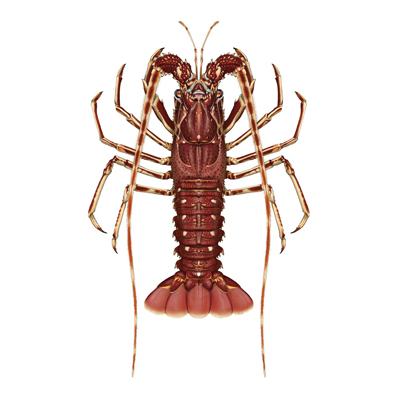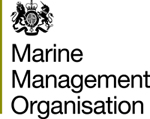

A relative of the lobster, the crawfish is a beautiful spiny crustacean that was once far more common around Cornish shores. Unlike a lobster they are an orange golden colour and are covered in spines. they also lack large claws, instead being equipped with spikey multi-purpose front legs and huge antennae. Crawfish are highly prized by the French and the Spanish and are suffering from overfishing throughout their range although stocks appear to be recovering in recent years in Cornish waters.
Crawfish were brought close to eradication in our waters following widespread capture by divers and netters in the 1960’s and early 70's. Following a surprise resurgence in the last few years catches of commercial landings of crawfish have massively increased in Cornwall. Although populations are high there are no limits on quanties of this species landed or the amount of effort on this stock. There is a minimum landing size but that alone is unlikely to prevent overfishng as was shown before. Better management is urgently needed, and indications are that unselective gill netting may already be resulting in overfishing of this recent recolonisation.
In 2021 a total of 38.3 tonnes of crawfish were landed to Cornish ports with a value of £982k (MMO data).
Cornish vessels landing to Cornish ports
Caught in baited traps deployed on the sea bed.
Learn moreCornwall
Caught by divers. In the past this has led to over exploitation of this species over reefs and wrecks within diveable depths.
Learn moreCornish vessels landing to Cornish ports
Gill nets are lightweight nets made of nylon (monofilament) fishing line that are anchored to the seabed and are used to catch fish by entangling the gills. Tangle nets set on the seabed are particularly dangerous for crawfish.
Learn moreCornwall Good Seafood Guide rates fish on sustainability using a scale of 1 to 5.
1, 2 and 3 are recommended, Fish to avoid are rated 5.
We use the system devised by the Marine Conservation Society (MCS) so our scores are comparable with the scores produced by MCS for the UK and fisheries from all around the world. For more information on scoring click here.
Crawfish, also known as European spiny lobster, are a warm water species that are at the northern limit of their distribution in Cornish waters. Crawfish make rasping noises (creaks) which they are thought to use to communicate and warn other crawfish of danger (Buscaino et all 2011). Young crawfish are called ‘miracle fish’ by north Cornish fishermen. Unlike lobsters Crawfish are far more mobile and are known to migrate for large distances over the seabed. They are thus very vulnerable to being caught in monofilament gill nets (tangle nets) set on the seabed for Monk and turbot. They are long lived animals living for at least 15 years. More research is needed on their reproductive patterns in our waters. ‘Berried’ females carrying eggs are found here occasionally but it is also thought that their larvae are carried here with warm water currents so stock recruitment may depend on the health of stocks in Brittanny, the Bay of Biscay and the coast of Spain. In the Atlantic Crawfish undertake migration inshore in spring to breed and offshore again in late autumn (R. Goni and D. Latrouite 2005).
This stock is poorly studied. Catches and catch per unit effort declined massively between 1977 and 1996 after the introduction of monofilament trammel nets and tangle nets to catch crawfish off Cornwall. MMO landings data to Cornwall shows an increase in landings since the mid 90’s. Since 2016 CIFCA have been recording detailed landings infomation on crawfish. It appears that recent increases in crawfish reported in Cornish waters is due to a successful recruitment event,with larvae most likely to have been brought here from brittany by ocean currents. Conservation efforts in Brittany in 2007 resulted in a large protected area within the Marine National Park Iroise, set up by fishers who were worried about the impacts of net fishing for crawfish. An area In the Chausee de Sein was closed and the area has seen significant recovery of populations of crawfish. There are now large numbers of crawfish in Cornish waters however without better management it seems likley that the population could be overfished. Landings of crawfish to Cornish ports have increased dramatically since 2019. Crawfish stocks are scored using Route 2 , medium resilience, no concern for B concern for F. 0.75
Currently most crawfish caught in Cornish waters are caught using monofilament nets (tangle nets or trammel nets) set on the seabed. They can also be collected by divers, a method that can extremely rapidly deplete stocks on key sites such as wrecks or reefs. Both methods combined led to a crash in crawfish populations during the late 1960's and early 1970’s. Without careful managment there is a high risk that this pattern could be repeated.
Pots with wide openings can be used sucessfully to catch crawfish as has been demonstrated in the Isles of Scilly and in Ireland but it is tricky and at present many fishers are using monofilament nets. Fishing pressure needs to be capped in some way to ensure sustainablity and it is encouraging that fishers want to see managment brought in.






Cornwall Good Seafood Guide is underpinned by the Marine Conservation Society (MCS) Good Fish Guide. The first UK consumer guide to sustainable seafood. For more information visit www.fishonline.org
Cornwall Good Seafood Guide is here to help us all make sustainable seafood choices. Choices that will help us keep the oceans healthy and Cornish fishers' futures safe. This website is funded by Cornwall Wildlife Trust. If you would like to make a meaningful difference to the health of our oceans, please consider making a donation to the Cornwall Wildlife Trust Ocean Emergency fund. Your donation will help safeguard these remarkable environments, ensuring that they continue to thrive for generations to come. Together, we can be stewards of the seas and champions for a healthier, more sustainable future.